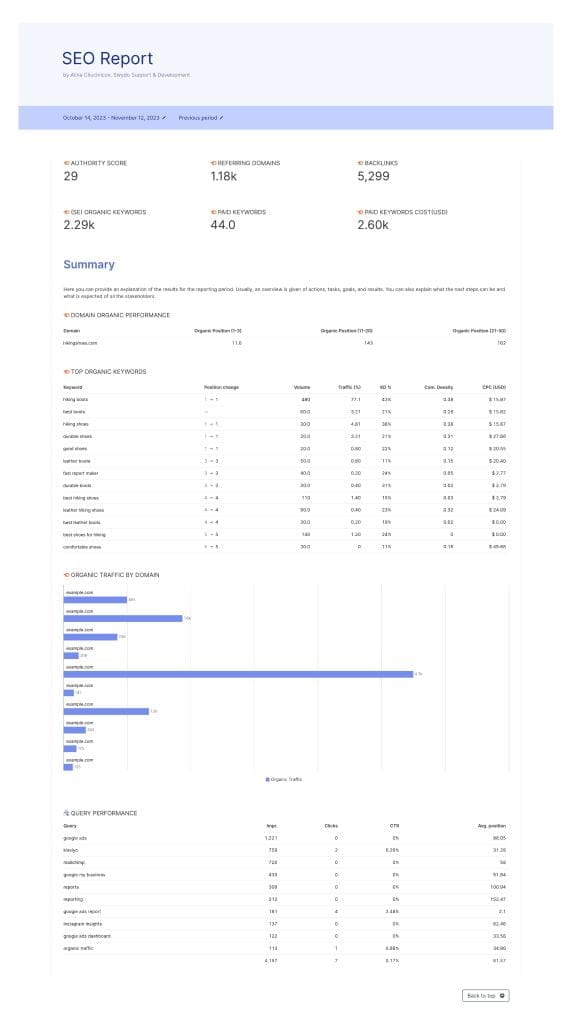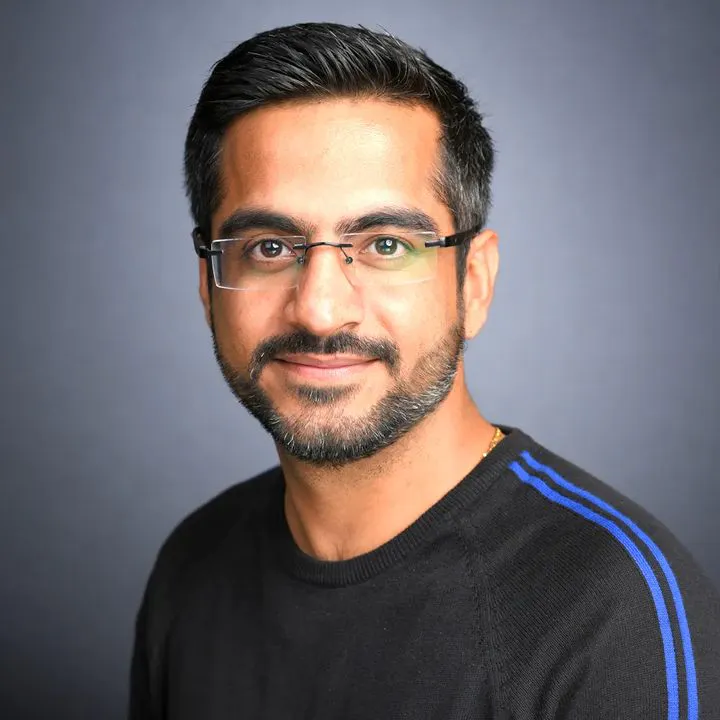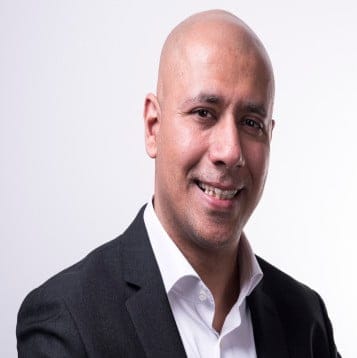Hello, fellow click-wizards. Did you know that in 2022, 34% of marketers credited Search Engine Optimization (SEO) for bringing in their most qualified leads? That’s right – SEO isn’t just a buzzword; it’s a crucial player in our digital marketing game. But to harness its full power, we’ve got to get savvy with our SEO client reporting.
This blog draws insights from seasoned SEO professionals Dana DiTomaso and Gus Pelogia on Crawling Mondays by Aleyda Solis and aims to guide you with practical, expert tips on simplifying your SEO client reports.
Understanding the Essence of SEO Reporting
Firstly, it’s crucial to distinguish between SEO reports and dashboards. Reports are about results and progress, while dashboards focus on the nitty-gritty diagnostic details. Remember, not everything needs to be in a report – target only what the decision-makers need to see.
Dana DiTomaso emphasizes the importance of aligning with clients on what constitutes a “report.” Clients may have varying expectations, from dashboards to detailed spreadsheets. Begin by establishing a common language and understanding of what the client truly needs.
💡 Expert Tips:
- Set reporting objectives together and revisit them regularly.
- Be transparent and upfront about what you can and cannot deliver.
- Use the client’s language and terminology in reports.
- Tailor your reporting format to meet the client’s specific needs.
Visual Over Tables
SEOs often default to tables, but many people are visual learners. Transform data into visually appealing formats instead of relying solely on tables. It’s not about the volume of data but the insights it provides.
Visualizations can often convey complex data more effectively than tables and Google spreadsheets. “The client doesn’t actually care about the 24 pages of data that you care about; they might care about these three things that matter to them. Don’t overdo it. Use their language and include microcopy in reports to explain concepts. Make sure clients understand what they’re seeing,” Dana emphasizes.
Aleyda agrees, “A common pitfall in SEO reporting is over-reliance on complex data presentations. Use clear and straightforward charts and graphs. The goal is to make the data easily digestible, ensuring that the presented information directly answers the questions related to the set goals.”
Crafting Reports That Drive Decisions
Align Reports with Business Goals
Reports should resonate with business goals and client requirements. If a CEO is more interested in ROI and conversion growth, tailor your report to these metrics. This customization ensures that your report is relevant and actionable.
Understand the metrics that are crucial for your client’s business. Reports should bridge the gap between SEO efforts and business outcomes. If your report doesn’t address the client’s key concerns, it’s missing the mark.
Tailoring Reports for the C-suite and Specialists
Use language and terms familiar to your audience. Avoid SEO jargon that can confuse decision-makers. If necessary, include microcopy in reports to explain terms and metrics. It’s not just about presenting data; it’s about making it understandable.
When reporting to the C-suite, condense the complexities of SEO into high-level insights. Showcase how SEO influences business goals, provide a snapshot of traffic and conversions, and offer a high-level view of ROI. Add a touch of competitor benchmarking to give executives a clear market standing. Remember the emphasis is on high-level insights like:
- SEO’s impact on business goals.
- Overview of traffic, conversions, and ROI.
- Competitor benchmarking insights.
- Opportunities for growth.
- Risks and mitigation strategies.
SEO Specialists, on the other hand, revel in the details. They need in-depth analytics to tweak and tune their SEO strategies. To improve communication with their development team and content writers, specialists need comprehensive data on important SEO metrics that measure on-page optimization efforts like:
- Keyword rankings and changes.
- Backlink profiles and growth.
- On-page optimization metrics.
- Site ranking reports.
- Site speed.
- Broken links.
- Page speed analysis.
- Page authority.
🔍 Have you conducted your SEO audit recently? Here’s a 10-step SEO audit checklist by Semrush to get started.
💡 Expert Tips
- Translate technical SEO jargon in the microcopy.
- Provide a glossary of SEO terms for reference.
- Use visuals to illustrate complex concepts.

Elements of a Good SEO Report
Conciseness and Relevance
Reports should be concise and relevant. Focus on results, the tests you’ve performed, and what’s next. This approach not only provides a snapshot of current performance but also sets the stage for future actions. Aleyda highlights the power of data storytelling in engaging your audience. This approach gives context to the data and influences future strategies. A narrative style can make reports more relatable and understandable. Especially for non-technical stakeholders, it helps build stronger client relationships.
“Don’t make everything equally important. Highlight critical issues that require immediate attention. Focus on executive summaries. Summarize what’s working, what’s not, and what actions will be taken. Results are great, but you need to show what’s happening next. Give clients that peace of mind, so they know what’s coming.” Gus says.
Leveraging Tools and Technology
Modern automated reporting tools like Swydo, Looker Studio, BigQuery allow for more streamlined and efficient reporting. Utilize these tools to create reports that are both informative and easy to navigate. “Use presentation mode and separate data into pages. Don’t put everything on one page; it will crash your report,” cautions Dana.
At the same time, Aleyda warns against the use of misleading KPIs, such as proprietary metrics from tools like Semrush or Ahrefs, which may not align with actual business outcomes. While it’s great to monitor them, for your client reporting – it’s critical to choose KPIs that truly reflect the success and impact of SEO efforts.
💡 Tips to Avoid Common Pitfalls
- Overemphasis on Length: Avoid the trap of equating the length of a report with its quality. Lengthy reports can be overwhelming and often unnecessary.
- Ignoring Client’s Business Metrics: Understand the metrics that are crucial for your client’s business. Reports should bridge the gap between SEO efforts and business outcomes.
The Path to Better SEO Reporting
An effective SEO report is less about data dumping and more about strategic communication. Tailor your reports to your audience, focus on actionable insights, and use the right tools to present data effectively. Remember, the goal is to make SEO reports a tool for decision-making, not just a monthly obligation.
By navigating these aspects of SEO reporting, digital marketers can turn their reports into powerful tools for strategy and growth.
Swydo Unifies Your SEO Data for Smarter Marketing Decisions
Now, with all that knowledge in hand, you can figure out exactly what tweaks you need to make to your SEO client reports.
You’re probably using Semrush, Google Analytics, Google Sheets, and Google Search Console, right? And maybe you have a few other favorites to throw into the mix. Here’s where Swydo steps in. It pulls everything together onto one simple dashboard or report. Imagine this: no more jumping between tabs, no more creating complex presentations, and definitely no more downloading endless CSV files.
Just open your Swydo dashboard, where all your tracking tools are synced. We have plug-and-play templates ready for you to start tracking your SEO data. Connect your data source, and you’ll spot trends and patterns in a snap. And if you’re not on the Swydo bandwagon yet, why not give it a whirl? We’ve got walkthroughs and a 14-day trial waiting for you. See you on the simpler side.
Kernwoorden: SEO





